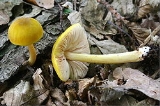
Pluteus leoninus
Encyclopedia
Pluteus leoninus, commonly known as Lion Shield, can occasionally be found growing on dead wood in Europe
and North Africa
. The underside of the cap is typical of the genus Pluteus
— the gills are pale, soon becoming pink when the spores ripen. But the upper surface is a bright tawny or olivaceous yellow. The species name leoninus (meaning leonine) refers to this cap colour.
Europe
Europe is, by convention, one of the world's seven continents. Comprising the westernmost peninsula of Eurasia, Europe is generally 'divided' from Asia to its east by the watershed divides of the Ural and Caucasus Mountains, the Ural River, the Caspian and Black Seas, and the waterways connecting...
and North Africa
North Africa
North Africa or Northern Africa is the northernmost region of the African continent, linked by the Sahara to Sub-Saharan Africa. Geopolitically, the United Nations definition of Northern Africa includes eight countries or territories; Algeria, Egypt, Libya, Morocco, South Sudan, Sudan, Tunisia, and...
. The underside of the cap is typical of the genus Pluteus
Pluteus
Pluteus is a large genus of fungi with over 100 species. They are wood rotting saprobes with pink spore prints and gills that are free from the stem.Pluteus means shed or penthouse.-Characteristics of the genus :...
— the gills are pale, soon becoming pink when the spores ripen. But the upper surface is a bright tawny or olivaceous yellow. The species name leoninus (meaning leonine) refers to this cap colour.
Description
- The golden to olive-yellow convex cap is 3–7 cm in diameter, is hygrophanousHygrophanousThe adjective hygrophanous refers to the color change of mushroom tissue as it loses or absorbs water, which causes the pileipellis to become more transparent when wet and opaque when dry....
, and usually has a grooved edge. The darker central disc has a slight velvety tomentumTomentumTomentum may refer to the following:*In botany, a covering of closely matted or fine hairs on plant leaves. *A network of minute blood vessels in the brain.* Tomentum in zoology are a short, soft pubescence...
. - The gills are yellowish at first, then salmon pink (the colour of the spore powder).
- The stipe is up to about 7 cm, often striate, being white to cream, and often darker near the base.
- The mushroom grows on stumps and wood debris of broad-leaved trees and sometimes of conifers.
- At the microscopic level, the filamentous cap cuticle is a trichoderm. The gills have scanty bladder-shaped pleurocystidia, and abundant fusiform cheilocystidia. The spores are smooth, almost globular, approximately 7×6 μm.

